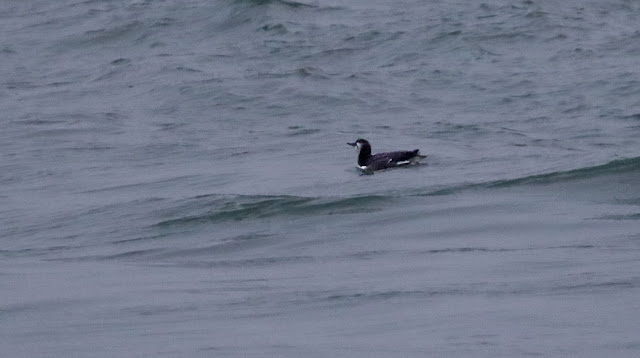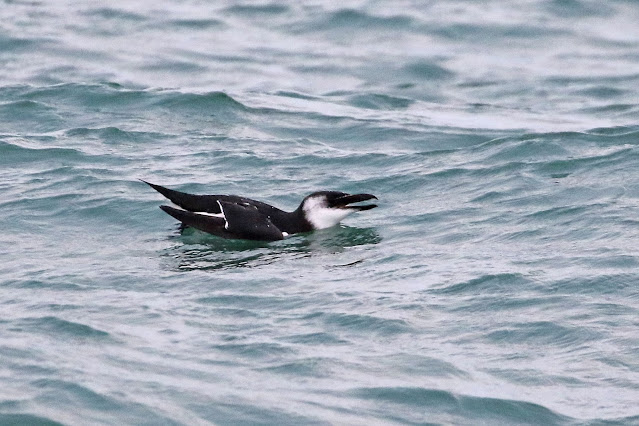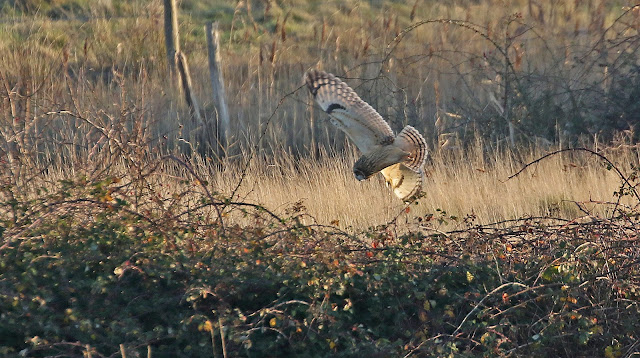After the excursions of last weekend it was back in Hampshire and meeting Ian at the fuel station just over Hayling Bridge. Today we were following up on some Hayling specialties that turn up almost every winter, but one in particular was a little rarer and this year had been putting in some good appearances. We traveled on south down the island, finding it hard to realise that it was nearly eight in the morning as it was so dark.
Kitted out, we walked onto the beach and headed east for Sandy Point on the south east point of the island. Here the sea comes in to Chichester Harbour as the tide rises, forced through a narrow channel, with West Wittering beach clearly visible. The opening to th3e harbour is quite narrow and the tidal current very strong as the sea water rushes in and then back out again as the tide falls
The last time we were here the world was just beginning to wake up to the possible impact of Covid-19, but not really understanding how much the virus was going to disrupt the world economy and personal lives over the coming two years. This morning as we walked we discussed the possible continued impact over Christmas once again.
Two years ago we were here for divers, it was the same again today, but hopeful of a rarer diver than the ones we saw then. Great Northern Divers are probably the commonest diver found in Hampshire, the rarest of the common three is the Black-throated Diver, two, maybe three have been present for over a week now and we were hopeful we could find them today. It was gloomy as we turned the corner of the spit, heading past the area of gorse and scrub that makes up the small nature reserve and on towards the Lifeboat station. Looking out across the water the green marker was the area of turbulent water

The photograph has been enhanced, in reality it was very gloomy still. Scanning the water we searched for divers and it didn't take long for Ian to pick one up, diving in the waves. It was time for the scopes and this picked up a very sleek and streamlined diver, lacking the abrupt shaped head of a Great Northern, much more rounded in appearance. This was a Black-throated Diver and here is a very poor record shot of said diver.
The diver continued to dive and a combination of the gloom and the waves made it difficult to get a clear view for any better shots. As I paused from watching the diver I noticed a Guillemot on the sea close in front of us. Where it had come from I have no idea.
It dived and then came up a little further along the beach, but still close in so we followed it once it had dived in the hope of it appearing even closer.
This winter there have been some good reports of the two commoner auks along the coast and into the Solent, many auks have also been found washed up dead. This bird looks like a first winter bird, showing a lot of white on the side of the head.
Here you can see the wings held down by the side of the bird, as it dives it does so with an open-wing action, using the wings as paddles to get under water.
Then as quickly as it came it was gone, so we turned back to the diver that had disappeared when a boat had steamed through, passing quite close to the post where it had been diving.
The light was getting better now, the cloud thinning and letting more of the winter light through creating a wash of pink and grey in the sky.
The another auk appeared this time to our right, close in a again along the beach. It dived so we raced after it and as it surfaced it was clearly not a Guillemot this time. This auk was a little more sturdier and thickset with a larger head, but more striking was the oblong shaped bill as opposed to the slim pointed bill of the Guillemot. This was a Razorbill.
The Razorbill in winter plumage has a more solidly capped appearance, the Guillemot showing much more white. The Razorbill is also slightly larger than the slimmer Guillemot. The Razorbill also has a noticeably longer tail that contributes to a "banana" shape as the tail is cocked when on the water.
Again this is a first winter bird, the bill lacking any white markings that are seen on the adult birds in the winter. Interestingly we were able to anticipate when it was about to dive as it would open the bill as shown here as if taking a large breath.
Like the Guillemot the wings are held slightly out and by the side, the wings being used to propel the auk under water.
The legs, as you can see here, not used to dive.
As it dived we followed it until eventually it swam away around the rocks on the point.
Back to the divers we found an immature Great Northern Diver, again in the rough water, distant and frequently diving. Both auks appeared sporadically which naturally prompted questions amongst the two of us as to how many of them there could be.
A Pied Wagtail flew on to the tidal washed sea weed on the beach.
We decided to walk along the beach towards the Sailing Club and disturbed a single Sanderling scouring the edge of the tide. It eventually flew of to join three more that then headed across the water towards West Wittering.
Rather than walk around to Black Point we crossed into the bay created by the spit on the other side. Brent could be seen on the water and a single Grey Plover stood on the beach before we got too close and it flew off to join the roost of more Grey Plover, Dunlin and Oystercatcher.
We decided to head back, but were stopped once again as we came across the divers again in the rough waves. Here the Great Northern.
Then we were able to watch the Black-throated Diver drift with the tide while preening and eventually wing flap.
The clouds were starting to break up and this was allowing shards of light through, scattering silver sparkles across the sea to the south.
Next stop was the Hayling Oyster Beds, oysters have been farmed on Hayling since the early nineteenth century and on and off until the 1970s and became a delicacy that was exported throughout the
country under the classification of “Emsworth Oysters”. Large complexes
consisting of several pens separated by a series of bund walls were built to
contain the oysters at varying stages of growth.
Although large sections of the bund walls have since
collapsed into the harbour, much of shape and scale of the beds can still be
seen today. In 1996, the oyster beds on
the north west coast of Hayling Island were restored by the Havant Borough
Council, creating a wildlife haven which has become an important wintering and breeding
site.
At high tide many waders use the bund walls as roost sites and this is what greeted us we walked along the main Billy Trail path.
The waters of Langstone Harbour were much calmer than those we had experienced earlier this morning. Along with the waders there were Brent, Wigeon and Pintail while a female Red-breasted Merganser was close in to the footpath.
A Curlew on one of the old walls of the lagoons.
We walked around to the north west side of the lagoons, from where we could view the lagoons and scan out into the harbour both north and south. As I scanned the water I picked up a Long-tailed Duck heading towards the Broadmarsh area, dropping out of sight, very distantly.
A pair of Red-breasted Mergansers flew into the lagoon just after I said there is nothing on the lagoon other than Little Grebes.
The Long-tailed Duck was one of the hoped for birds to be found here, the second I managed to find as I scanned out into the south of the harbour, Five distant Black-necked Grebes.
Beyond the grebes was a group of four Goldeneye, two pairs and the males were displaying by throwing their heads back and pointing to the sky
The view looking north across the oyster bed lagoons, the skies now clear and a beautiful blue sky.
Time was moving on and we had to be across the border for the afternoon. However as we walked past the flooded area on the east side of the main path Ian found a Greenshank. At first it looked as if it had orange legs, then we realised it was blinged up with an orange and red ring on the left leg, and yellow on the right. Sitting in the winter sunshine with a background of the dark water.
Moving around to look south, the Greenshank was closer, but you were viewing into the sunshine. Love the contrast with the brown, grey and white.
As well as the Greenshank a Little Egret was posing nicely alongside a clump of vegetation.
After something to eat and drink we headed off for the short trip to Thorney Island. Once again the weather was lovely with blue skies and the lovely winter sunshine, the one difference from our last trip was the wind, it was a lot calmer and coming from the east today.
We headed to the sea wall where the tide, while a dropping high tide like last time, was not as high and there was mud and saltmarsh visible. The light, once again was beautiful.
Beautiful reflections of the reeds in the water while Teal snooze in the sunshine.
With it being just after midday we walked down to the Deeps, continually checking the fields for any movement. There were plenty of Coot on the lake, while the duck today were represented by Wigeon, Pintail and Shelduck. Oystercatchers were making their way from the roost out into the harbour. On the east side we could see large flocks of Lapwing and Golden Plover, probably being put up by the Peregrine that we had seen two weeks ago. A micro-light flew over and this spooked a large flock of Black-tailed Godwits and they flew over our heads and out into the harbour.
A calling Greenshank alerted us to one being close, but then one became ten as they were spooked by a Sparrowhawk that came low across the Deeps and out over the fields.
A Redshank caught a crab below us in amongst the mud and sea weed.
The view across Chichester Harbour.
Alone Curlew flew over the sea wall perfectly lit up by the sunshine.
We were now sitting on the sea wall waiting in anticipation for the main act, everything was set, the scenery, the lighting and the audience.
Then at 14.22 Ian picked one Short-eared Owl up sitting on top of the bushes, it the dropped away and started to quarter the long grass in front of us.
The lovely flap and glide accompanied by twists and turns all played out around the gorse and bramble bushes. We watched willing it to come closer.
This bird then headed out across the field where it flushed out two more owls, a short interaction and then they went on their separate ways, covering a long way across the lake and then back again. Every so often one would twist and turn and then dive into the grass only to appear straight away to continue the quartering.
Every so often they would rest, using a pole, bush or fence as a suitable place to recharge the batteries and survey their surroundings with those beautiful yellow eyes.
We stayed on the sea wall, resisting the need to drop down to the bottom path, this way we could track the movements and see where the owls were going. At one point a Buzzard cruised over and was intercepted by an owl and escorted away from the field.
The closest they came was to the long grass and gorse close to the ditch, but never close enough for that killer image, meaning there is a need to go back, but for now it was just wonderful to watch three Short-eared owls hunting in the perfect conditions, no wind and lovely low winter sunshine.
One of the owls had a very dark brown body, while the other two were much paler.
They kept to their own areas, with plenty of field to hunt in this wasn't difficult, but every so often they would get to close and this would happen following a shriek. Interestingly the talons are not evident so maybe the interaction is more about bravado than intent.
The last piece of action was of one owl twisting above or alongside a bramble bush before dropping out of sight.
Sunset was due around 16:00, the skies were clear but the sea wall and bushes were throwing long shadows across the field with still thirty minutes to go. This seemed to have an impact on the owls and all of a sudden they seemed to stop hunting. I waited for a while but the light was going so I decided to head back to the car.
Looking across the harbour the water in one of the channels was reflecting colours nicely.
Looking on the other side of the sea wall the reed bed was now a gorgeous golden brown and russet red, superb.
And so ended a great day with some quality birds, but to be honest any day where you can sit and watch a Short-eared Owl hunting is a great day!




























































No comments:
Post a Comment